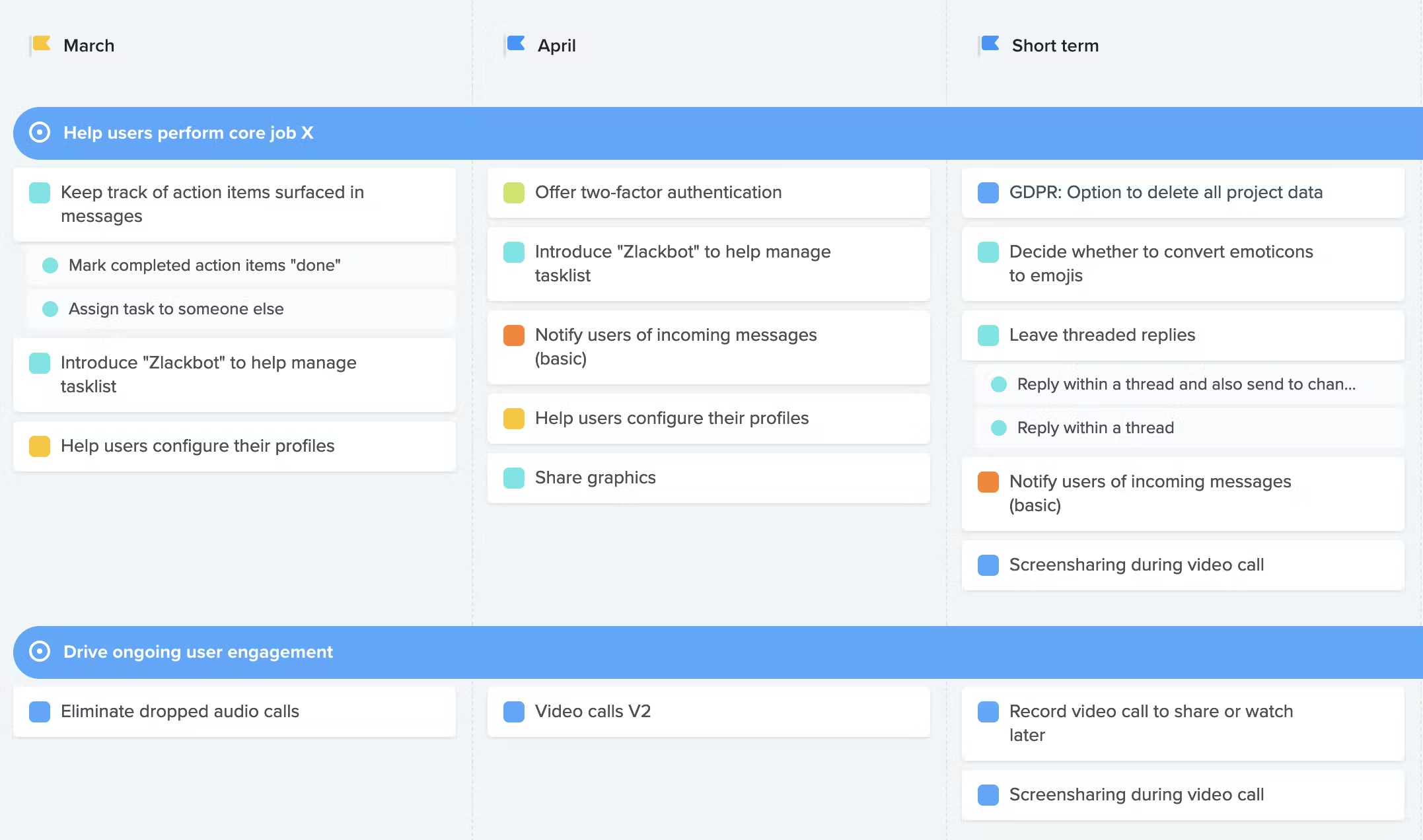According to a 2019 Roadmap.com survey, 50.3% of product managers think their company’s overall strategy lacks clarity. Which makes sense — top-down directives, even those with merit, are often too nebulous to provide the kind of guidance teams need to drive results.
So, how do you add in the necessary level of clarity and direction that makes best-in-class product teams successful? It’s simple, really: create a product plan.
A well-defined product plan clarifies your team’s priorities and makes it easier to build the types of product experiences that are truly valuable for customers. And it alleviates any issues with unclear communication from the 10,000-foot goals often defined by company leadership.
Building a great product is all about getting from point A to point B efficiently, which requires a clear sense of priorities. Creating a comprehensive product plan ensures the effort you put into developing new products isn’t wasted on tasks that don’t add value to the process. In short, it sets your team and your product up for success.
What Is a Product Plan?
Product plans offer an overview of your new product, including the time it takes to build, the monetary and operational costs, your team’s available resources, and the overall strategic approach to execution. It clarifies all the moving parts that need to come together for your team to work efficiently through their individual workflows.
Your product plan should also include any potential issues or bottlenecks you’ve identified throughout the planning process. It’s important to address anything that could delay a step in the product development process before it has a negative impact on your team.
Creating these plans also helps you refine and optimize various product development workflows over time and create templates for the different types of work that need to be done at each stage of the process. And it keeps each member of your team connected to the overall customer value of each release.
What Goes into Building a Product Plan Template
There are a number of different ways to map out your product plan. Often, your product plan template follows the same structure as your overall product roadmap, but it can also take the form of a project charter or spreadsheet.
To get started, create a product plan template in the spreadsheet tool of your choosing. This is a simple way to visualize all the information, such as objectives, metrics, tasks, and responsibilities, that need to be completed for a project to be officially released.
Or you can use tools like ProductPlan, Jira, monday.com, or Productboard to build your product plan into a fully-fleshed-out roadmap and work through the workflows with a single tool.

Product roadmap template via productboard.
The overall design of your product planning document will change based on whether you use a product management tool or do something in-house.
How to Build a Winning Product Plan
Putting together a concrete product plan ensures that every member of your team knows how to move the project forward toward a shared goal. With a little bit of input at the beginning of the process, you can proactively address any issues before they impact your bottom line.
1. Define Objectives and Key Results (OKRs)
The first step in creating an effective product plan is to define what you want to get out of the product release. This means creating objectives and key results (OKRs) that help you define the value for your business, customer, and team. Without these goals, you can’t create a product plan that leads to verifiable results.
These OKRs should start out as SMART goals. The SMART framework ensures that your product makes an impact on overarching company objectives by making sure each product has a specific, measurable, attainable, relevant, and time-bound goal to strive toward as a team.
Make sure that your OKRs clearly define “why” you are building the product. This helps anchor your team in a shared vision of the real-life impact your upcoming release has on customers and the market.
2. Nail Down Requirements
With your OKRs set, it’s time to refine them with project requirements. These requirements help you contextualize each goal or OKR and ground it in reality. These requirements help your team narrow in on exactly what is required from each of them throughout the development process.
For example, if your OKR is increasing in-app chat engagement by 5% in Q3, the requirements you need to list are common issues with in-app chat, customer pain points, and any other underlying causes of decreased engagement. To get started, talk to your customer support, marketing, and sales teams. They interact with potential customers on various different levels and truly understand the real-world customer problems your product will solve.
But nothing will help you understand your customers’ requirements like talking to people directly. Discovery interviews help you identify common issues across various customer personas and show you exactly what they want out of the product experience.
3. Assign Team Responsibilities
Now that you’ve nailed down requirements and OKRs, it’s time to put together your team and assign responsibilities. Including these responsibilities in your product plan ensures that each member of your team knows what’s required of them, what’s required of others, and how all those responsibilities impact one another.
One of the best ways to do this is by using the RACI model—an acronym for Responsible, Accountable, Consulted, and Informed. This framework helps you determine what every member needs to do at various points in the development process and clarifies how each of them works together.
Assigning concrete responsibilities in your product plan ensures that every member of your team, from top to bottom, can address potential bottlenecks or bandwidth constraints before they cause issues for your release.
4. Create a Timeline
Creating a timeline for every project helps you predict how quickly you see the revenue and customer impact of every project. And that timeline creates visibility into the work required to get everything done. Every member of your team should know how much time is allocated to their individual tasks, as well as the impact on other tasks in the pipeline.
Often, these timelines are visualized as a roadmap, and there are many different types of roadmaps you can use. Just make sure that the one you choose incorporates your OKRs and requirements, as well as the product development framework your team uses to execute on their work.
Connecting this timeline to each stage of the product development lifecycle helps you refine your approach to product development, pivot faster, and make better plans for the future.
5. Share Your Plan with the Team
Your product plan isn’t going to work unless it’s visible to the entire team, which is why it’s so important to share it publicly. Sharing your plan opens it up to feedback and ensures that everyone can keep themselves accountable. Your team can easily get bogged down with day-to-day responsibilities—visible product plans help them step back and view the project through a different lens.
Define a part of your internal wiki for product plans, and document everything related to each project. Having a single source of truth ensures that everyone understands how and why they’re moving forward in a particular direction. And you can reference these plans in the future to refine your processes and workflows based on previous experiences.
Sharing the plan publicly also increases engagement with other members of your organization and gets them excited about new projects and opportunities. When you communicate a product’s value in this way, it shows every member of the team how much of an impact their work has on your company, as well as on the customer.
Common Issues in the Product Planning Process
Creating an effective product plan is all about providing the right kind of context for your team at each stage of the product development lifecycle. To provide that context at scale, you need to highlight strategic objectives and timelines while also distilling a lot of information into an easy-to-digest document.
There are a number of issues you can run into that cause confusion for your team, so it’s important to address those proactively as you create your product plan. These issues center around four core themes:
- A lack of a company-level vision or strategy leads to an absence of overall product direction. That lack of direction increases issues with scope creep and can cause decreased buy-in from stakeholders throughout your team.
- Having no clear target user makes it difficult to nail down the value of your product. This ends in lower customer engagement with the product upon release and a negative perception of your company in the market.
- Undefined processes and workflows delay releases and cause confusion within the team. Without a clear sense of priorities, it’s impossible to move forward with a given task, which will cause both individual employees and the team to burnout.
- Lack of visibility into the team’s progress adds to this confusion and burnout while also causing missed deadlines and unnecessary bottlenecks. These delays demoralize your team and negatively impact your company’s bottom line.
When you consider these potential issues throughout the product planning process and think of ways to address them, you set every member of your team up with a clear path forward. So much of the product development process depends on your ability to execute on various tasks as efficiently as possible—and your product plan is the document that helps you accomplish this goal.
Product Plans Make Collaboration Simple
Product development is a collaborative endeavor. Every member of the team needs to have a clear and comprehensive understanding of your product vision, how you intend to build it, and what they’re responsible for. Product plans communicate all this information for you and make it easy to build a valuable and engaging product for your customers.
Interested in learning more about Stream’s scalable APIs? Try Stream’s free, 28-day Chat trial!

